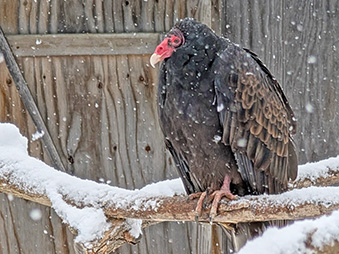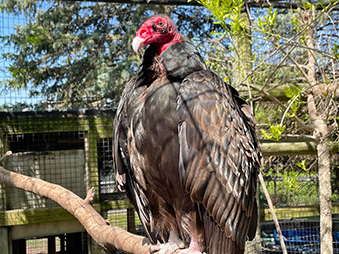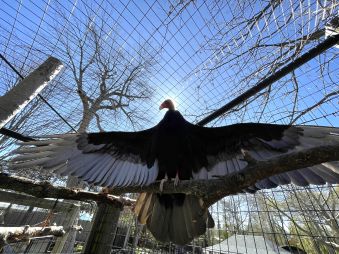Cathartes aura | Turkey vulture
Name: Sammy (Male)



Meet Sammy the Turkey Vulture
From the skies over Canada to the southern tip of South America, Turkey Vultures like Sammy are nature’s ultimate clean-up crew! With her impressive wingspan and signature featherless red head, Sammy helps educate visitors about one of the most misunderstood—but critically important—scavengers in the animal kingdom.
Nature’s Janitor
Turkey Vultures are carrion feeders, meaning they specialize in consuming dead animals. While it may sound unpleasant, this role is vital for ecosystem health. By removing rotting carcasses from the environment, vultures help prevent the spread of dangerous diseases.
Their digestive systems are uniquely adapted for the job. Turkey Vultures have the most acidic stomachs of any vertebrate, capable of neutralizing harmful bacteria such as anthrax, botulism, and even rabies. This powerful trait makes them nature’s first line of defense against potential disease outbreaks.
Although they prefer fresh carrion, Turkey Vultures lack the strong beaks needed to tear into the thick hides of large animals. Instead, they often wait until a carcass is partially decomposed before feeding or consuming smaller animals. When meat is scarce, they’ve also been known to eat decaying fruits, vegetables, and occasionally hunt for insects, reptiles, or nestlings.
Clean Design
Ever wonder why Turkey Vultures have bald heads? It's not just for looks. A featherless head stays cleaner while feeding and reduces the risk of bacteria becoming trapped in their plumage. You might also see Sammy standing with her wings spread wide—this “horaltic pose” isn’t just striking, it helps sterilize her feathers using the sun’s UV rays.
Dining with Sammy
At the zoo, Sammy enjoys a varied, protein-rich diet that mimics her natural menu. This includes specially formulated Bird of Prey meat, knuckle bones, mice, chicks, and fish—providing her with the nutrition and enrichment she needs to thrive.
A Nose That Knows
Unlike most birds, Turkey Vultures rely heavily on their incredible sense of smell to locate food. They can detect gases emitted by decomposing animals from miles away—even beneath dense forest canopies. Their sense of smell is so reliable that other vultures, like the less olfactory-savvy Black Vulture, often follow them to a meal!
Masters of the Sky
With a wingspan reaching up to 6 feet, Turkey Vultures are built for soaring. Thanks to their lightweight bodies and broad wings, they can glide for hours on rising thermal currents without flapping—an energy-efficient way to cover vast distances in search of food.
Spotting one is easy if you know what to look for! In areas like Saginaw, watch the skies for a large, dark bird with long wings. If the wing tips look like spread fingers and the bird rocks slightly in flight, chances are it’s a Turkey Vulture.
Fact Sheet
Taxonomy
Genus: Cathartes | Species: aura
Kingdom: Animalia | Phylum: Chordata | Class: Aves | Order: Falconiformes | Family: Cathartidae |
Favorite Enrichment Type
Cardboard boxes to shred, hoof trimmings, and knuckle bones.
Diet
- In the Wild: Prefer fresh carrion, but will consume decayed animals, and sometimes rotten fruits and vegetables. On occasion, they have been known to prey on reptiles, young birds, and insects.
- At the Zoo: Specially formulated Bird of Prey meat, knuckle bones, mice, chicks, and fish.
Life Span
- In the Wild: About 16 years
- In Human Care: Up to 30+ years
Geographic Range
Southern border of Canada all the way to the Southern-most tip of South America.
Habitat
Open and forested areas and easily live alongside humans and human development.
Did You Know?
- Turkey Vultures rarely kill their food—they prefer to scavenge.
- They belong to the New World vulture family, found only in the Americas.
- When threatened, they may vomit as a defense—it’s unpleasant but highly effective!
- That wings-spread pose they strike in the sun? It’s called the horaltic pose (last above image, third from the left).
Status: Least Concern
Adaptable and Resilient
Turkey Vultures are incredibly adaptable birds, thriving in a wide range of environments—from sun-scorched deserts and open plains to dense forests and rugged mountain regions. As long as there’s carrion to eat and warm air currents to ride, they can call just about anywhere home. This flexibility is one of the main reasons they’re currently listed as a species of Least Concern.
In the wild, Turkey Vultures typically live around 16 years. However, under human care—like Sammy at the zoo—they can live up to 30 years. Her long, healthy life is a testament to both the resilience of her species and the excellent care she receives.
Though their populations are stable, there are still important ways we can help ensure these remarkable scavengers continue to thrive for generations to come:
- Avoid using lead-based ammunition or fishing weights. Lead is highly toxic to birds if ingested, often through contaminated carrion or bait.
- Pick up unused fishing line. Discarded line can entangle birds or be accidentally swallowed, causing serious harm.
- Be alert while driving. Turkey Vultures often feed on roadkill and may struggle to take off quickly due to their size. Slowing down can save lives.
- Don't feed wildlife. Sharing food with animals, including vultures, can encourage aggressive behavior and dependency. Keep wild animals wild.
- Leave natural spaces better than you found them. Always clean up trash while hiking, camping, or exploring. This helps prevent scavengers like Turkey Vultures from ingesting harmful waste.
By taking small actions, we can help protect not only Turkey Vultures but the entire web of wildlife they help support.
How to Find Me
You can visit Sammy in the Forgotten Forest, in between the Mexican wolves and the Llamas. Whether she’s sunning herself with wings outstretched, or gliding across her habitat, she’s a striking reminder that even the messiest jobs are worth celebrating.
